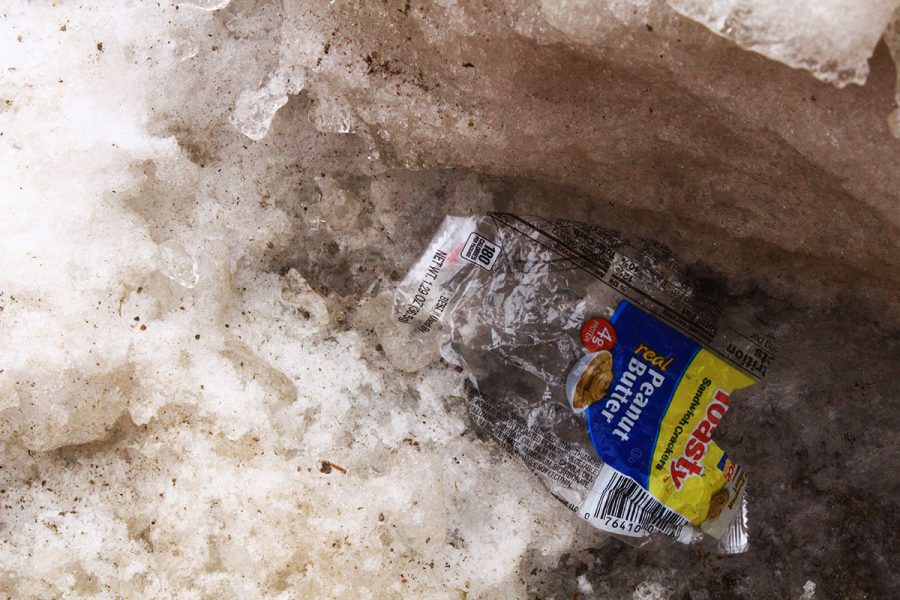Be nicer to the planet: nix individual packaging
One of the ways to help save the earth is to become a smarter shopper
Photo by Clara Neupert
A plastic food wrapper drifts into a snow pile outside Hibbard Hall. The Pew Research Center reports that when it comes to total recycled items, plastics like bags and food packaging account for less than 20 percent.
I don’t mean to brag, but I’ve been an advocate for the environment since I was in fifth grade. I remember being distraught over the BP oil spill. I sold my toys and donated the profit to the World Wildlife Fund. I wore shirts that read “Save the Earth!” and made bracelets out of pop bottle tops.
So, given my history, I’m a little ashamed to admit that my efforts to save the earth are clouded by a nasty habit: I still buy individually packaged foods.
The realization of my hypocrisy came to me over winter break, which is (admittedly) one big snack fest for me. I noticed a mound of plastic wrappers and trays in the trashcan after one week of hardcore snacking. I couldn’t stop imagining those plastic wrappers drifting between park benches or trays sitting in landfills.
Here’s my hypothesis: If we work together to reduce our plastic waste by avoiding individually packaged items, then we can take a big step towards reducing our plastic waste.
It’s no secret that Americans have a plastic problem. In 2014, Americans threw away 33.6 million tons of plastic and, globally, humans are buying a million plastic bottles per minute. Only 9.5 percent of all this rubbish is recycled. The sad majority ends up in landfills or floating in the soupy Great Pacific Garbage Patch.
Take a walk down any grocery aisle to find the culprits: chips embedded in seven layers of plastic, fruit snacks and yogurt cups. The list goes on.
We have to face the facts. We are part of a convenience culture that values what is quick, cheap and easy to throw away. To me, it sounds like we have commitment issues. Though our plastic problem is a big one, I’m optimistic there are solutions for both the consumer and corporation.
Decreasing plastic waste does not require a major lifestyle change for a shopper. Basically, it just requires being conscious of what goes into a cart.
For example, buy a larger container of yogurt instead of small cups. Get a big bag of chips instead of individual bags and purchase mac and cheese in cardboard boxes instead of plastic cups. Check for recycling symbols.
But before becoming a bulk-buying consumer, it’s important to remember that although buying in bulk can help the environment, it can also create food waste. After all, no single person really needs 13 pounds of Goldfish Crackers at once.
Be mindful at home, too. Tupperware or glass jars can serve as reusable containers on the go, housing smaller portions and nixing the need for plastic sandwich bags.
If consumers boycott excessively packaged products, a strong message will be sent to businesses that might cause them to rethink their relationship with plastics.
Luckily, the food industry can be aided by science. New recycling technology may lead to a smarter plastic sorting system and researchers are developing friendlier, biodegradable polymers. With the help of microorganisms, these plastics break down instead of sticking around.
Though my packaging waste is only a part of my impact on the environment, I’m aiming to hold myself accountable for my plastic purchases. I think fifth grade me would be proud.

Neupert is a fourth-year journalism student at UW-Eau Claire. She is the executive producer of Engage Eau Claire on Blugold Radio Sunday. In her spare time, Neupert's working on becoming a crossword puzzle expert.

